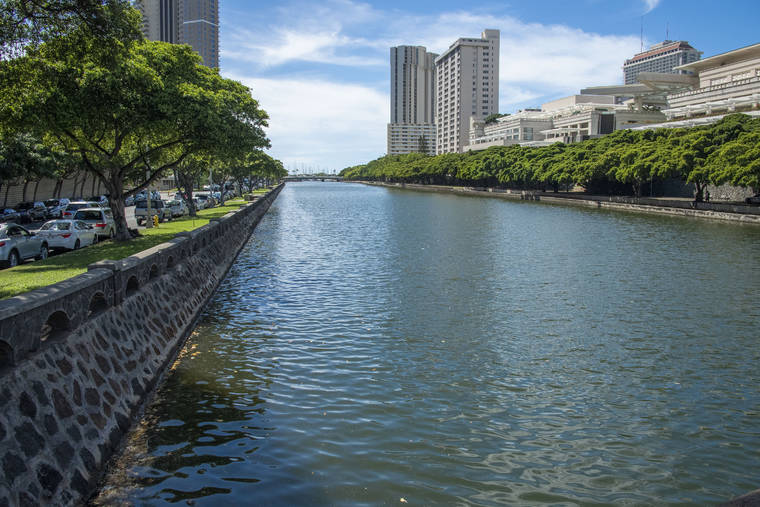The U.S. Army Corps of Engineers announced Tuesday a revised plan for the Ala Wai Flood Control Project with significantly fewer impacts on the natural streams and residential properties within the watershed, but the plan retains a large controversial pump and wall on the canal.
This new plan, laid out in an engineering report completed Aug. 6, recommends focusing on evacuating the water without detaining it in the upper sections of the watershed valleys, the Corps of Engineers said in a news release Tuesday.
It will still require a large pumping station on the Ala Wai and concrete floodwalls along the canal.
It will also require catchment basins to detain floodwater and debris at the Ala Wai Golf Course, Kanewai Field and Hausten Ditch.
One new feature is the Woodlawn Bypass feature
at the Manoa Marketplace to divert water from impacting the University of Hawaii at Manoa.
A good deal of the opposition to the original plan stemmed from residents opposed to the condemnation of private property.
Councilwoman Ann Kobayashi said, “Dave Watase (an opponent of the plan) fought them for months. That’s why there’s no detention basins and the Army Corps realized how important it is to work with the community.”
Ala Wai project manager Jeff Herzog said, “the new recommendation requires no homes to be purchased or condemned for the project.”
But because homeowners may own portions of the
affected streams, “any change in them and the amount of water requires some sort of flowage easement to ensure the water can evacuate,” he said.
He said there were multiple reasons for the change in the project. “The engineering data and modeling identified that changes to the system needed to be made,” he said. After several meetings with the community on the basins, “we identified our recommendation that fundamentally changed the project from a detention alternative with multiple basins to a conveyance system of features that evacuates the water to reduce risk on the community.”
The project was undertaken to reduce major flooding in a 100-year storm event, loss of life and long-term economic damage within the 19 square miles of the Ala Wai Watershed, which encompasses Waikiki, Manoa, Palolo and Makiki, as well as McCully, Moiliili and the University of Hawaii.
The revisions include eliminating six catch basins in the upper portions of
Manoa, Palolo and Makiki valleys meant to detain floodwater and debris and one in-stream debris catchment structure in Manoa.
Congress appropriated $345 million in 2018 in an emergency appropriation to invest in projects in flood-prone areas determined to be economically justified and environmentally compliant. The funds do not expire.
The total cost of the project is now projected at
$417 million.
Additional funds must come from the state and
the city.
The Corps of Engineers and the city must enter into an agreement beforehand.
Meanwhile the city has hired Oceanit to find a more attractive alternative to the corps’ plan.
Kobayashi, who represents Manoa, Palolo
Valley and portions of Makiki, Councilwoman Carol Fukunaga and Councilman Tommy Waters are part of a permitted action group that has been working with Oceanit.
In the event of a large storm, floodwaters from Manoa and Palolo streams will be taken straight out to the ocean by means of separate tunnels that start at the back of the valleys,
Kobayashi said.
“The tunnels really are
a more attractive plan,”
she said. “You won’t see them. There are no large pumping stations or walls. The difficulty is getting
the Army Corps to incorporate this tunnel” into its plan.
Although the cost of
the tunnels is roughly
$225 million, the council group is hoping to have
the corps work that into their plan. “One cost offsets the other,” she said.
“It would eliminate the big rush of water coming into the valley, and eliminates the need for a pump,” she said.
She said the current plan, without the detention basins, would allow a lot of water to come down into the valleys and the plan is to pump that water on the Ala Wai Golf Course and elsewhere.

